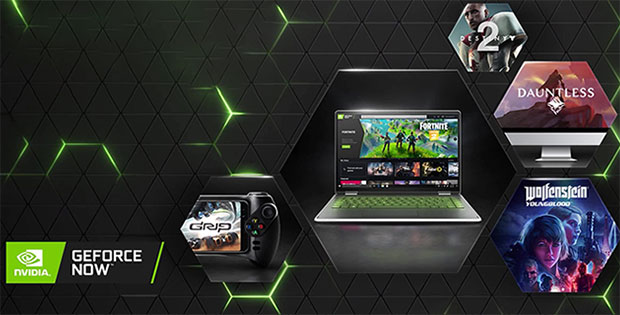One of the old sayings is that there are “lies, damned lies and statistics,” with the implication being you really can’t trust most reported numbers. Still, we’ve often thought, at least with major vendors, that you could trust rankings.
One current set of rankings involves cloud providers. The general impression was that Amazon was first, Microsoft second, and Google third. However, both Google and IBM reported numbers this month — and surprise. Google isn’t third, IBM is.
That isn’t the only thing I found interesting this month. IBM did what few firms never seem to do and followed the best practice of another firm — in this case, Microsoft — in making its CEO choice. This suggests that IBM eventually should be able to challenge for the No. 1 spot in the cloud. If it does, it could point the way for other firms, like Dell, to pass Amazon as well.
Since the subject is the cloud, I’ll shine a light on my new favorite cloud service: Nvidia’s GeForce Now, just released this month.
Cloud Rankings
The cloud is important. Much of what we now watch (Netflix) and buy (Amazon), as well as systems to guard our home’s security (like Arlo and ADT Plus) reside in the cloud. Much of it resides on the Amazon, Microsoft or Google cloud. It seems like a no-brainer to rank the players in order, with Amazon first, Microsoft second and Google third.
The only issue is that until recently, we didn’t know how much of Google’s revenue came from their cloud. Yes, it uses its cloud for massive services like YouTube, but we typically rank vendors based on what they sell, not what they use internally.
For instance, if Shell Oil built its own trucks and used thousands of them, it still wouldn’t displace GM or Ford in the rankings.
Google reported a decent US$2.6 billion in cloud revenue for the quarter, and $8.9 billion in cloud revenue for the year. However, IBM reported a whopping $6.8 billion for the quarter and $21.2 billion for the year. Note that IBM’s quarterly cloud revenue is within the shooting distance of Google’s annual cloud revenue.
IBM isn’t behind Google, and it isn’t a rounding error ahead either. It is almost three times the size of Google in the cloud market — which, by the way, suggests Google may be lower than fourth place.
If you think about it, it was Azure, Microsoft’s Cloud effort, that put the company back on the technology map and founded its valuation increase so it could challenge Amazon, Apple and Google for the most valuable company title. The same could happen to IBM as it further ramps its cloud efforts.
Dell has advanced its cloud offerings recently with the Dell Technologies Cloud, and I believe it also is in the hunt to take out Google and Amazon.
Why Google and Amazon Are Vulnerable
As much as you might like Samsung or Apple, would you buy a car from them? Some might, but most probably would feel, rightly, that cars aren’t these companies’ strengths, as both firms primarily make personal electronics.
IT buyers are even more pragmatic. Generally, they have avoided services — like Amazon’s — that come from a firm that doesn’t specialize in them.
This specialization mismatch is one of the reasons Apple’s server failed. It wasn’t a bad product — it was a decent server. It was that people didn’t trust a personal technology vendor to build a good server. If something bad happened, the buyer would look stupid. Looking stupid as an IT buyer is a quick way to discover you suddenly have no job and need to search for a new career.
Amazon’s primary business is retail. Would you buy a cloud service from Walmart? The reason Amazon rose to power is that companies like IBM didn’t have services like AWS — but they do now. Regardless of how many people now use AWS at the end of the day, IT buyers trust companies like IBM and Dell more than they’ll ever trust a retail store vendor for an IT technology.
Google is worse, by almost any measure, because its business is selling user data. If you discovered your confidential information had leaked to a competitor or hostile foreign government — even if Google didn’t do it — you’d wonder if someone in Google sold it.
With the chief security officer asking you how the breach happened — often the sources aren’t found — the fact that you used a vendor that sold customer information certainly would make it look like maybe you were the problem that needed to be solved.
Since pointing at a scapegoat is common when there’s an embarrassing breach, your decision to use Google wouldn’t bode well for your job longevity. IT folks know that, which likely is why IBM was able to roar past Google to claim the No. 1 spot and why I expect Dell will follow.
IBM’s Unusual Move
This progression of potential events takes us to IBM’s unusual move. Now I say “unusual,” because, for whatever strange reason, companies don’t like to copy other company’s brilliant moves.
For instance, Apple put in a CEO who was marketing-oriented with Steve Jobs and became the most valuable company during his time. Not even Apple followed that example, and you’d be hard-pressed to find any major company run by a marketing type today.
Microsoft replaced Steve Ballmer with a cloud subject matter expert (Satya Nadella) and now regularly challenges to be the most valuable company in the world. IBM just surprised the crap out of me and did the same thing, replacing Ginni Rometty with Arvind Krishna.
Both Microsoft and IBM are complex, and both firms have reputations that suggest their peers betray a lot of top executives in both firms, so this wasn’t a trivial move by either firm, or for the executives who took the jobs. However, I think IBM now will replicate Microsoft’s success.
In Praise of Steve Ballmer and Ginni Rometty
Before we move off this subject, I want to point out that neither Microsoft nor IBM would be in this place if it weren’t for Steve Ballmer and Ginni Rometty, both of whom set the foundations for success in their respective firms. Both took over when their firms were in deep trouble, and both built up the foundational elements in their firms, including making the initial cloud investments that created the platform and the subject matter experts who later took the CEO job.
If Ballmer hadn’t executed, there never would have been an Azure or a Satya Nadella. If Rometty hadn’t bought Soft Layer and restructured IBM, there would be no Arvind Krishna. It often is easy to contrast successful CEOs with challenged ones and find the latter wanting, forgetting that the successful CEOs wouldn’t have a place to be successful in, and often wouldn’t even have been considered for the job, had their predecessors not done their job.
Neither Steve nor Ginni will go down in history as their respective firm’s saviors, but they should. Without them, there never would have been a Satya Nadella or an Arvind Krishna.
Wrapping Up
At the end of the decade, I don’t expect either Amazon or Google to be at the top of the cloud market if we even call it that then. My expectation is they’ll have to spin out their cloud businesses to get them away from their non-aligned core brands, or they will be passed by more focused vendors like Microsoft, IBM and Dell.
I also think few companies will follow Microsoft and IBM’s lead and place CEOs in positions that require subject matter expertise — and that, as a result, the success of these policies will be lost to history. I truly hope I am wrong here, and the fact that IBM did follow Microsoft suggests I am. Let’s hope I’m right about being wrong in this case.
One of the most powerful demonstrations of what the cloud is capable of is cloud gaming. It has historically been an ideal way to see the weakness in these platforms, because PC gaming requires very high performance and very low latency.
I once got in an argument with Robby Bach, who then ran Microsoft gaming. I argued that cloud gaming was the future, and he felt I was mentally challenged because he believed you’d never get the needed performance out of the cloud.
Now a cloud guy is running Microsoft, Robby Bach is gone, and even Microsoft is rolling out a cloud gaming platform — the xCloud.
Well, Nvidia just released its GeForce Now platform with 50 top-flight games initially — more are coming — and thousands that can be played with single-session installs.
One fascinating thing is that Nvidia has done this first, not any of the leading cloud vendors, although Nvidia typically isn’t even on the cloud vendor list. As a specialized offering, this is an incredible service.

It does require decent Internet service and low latency, which means it will get a lot better when 5G rolls out. However, in anticipation of 5G, the telco and cable providers have been improving their infrastructure, and the service is very playable now.
I played League of Legends last week, and it played like it was on my gaming system, which is anything but underpowered. It was my product of the week last week. Oh, and that system is AMD-based, and GeForce Now had no issue with it.
The service works on both Windows and macOS machines, Android, and Nvidia’s Shield set-top box (one of the more powerful set-top box offerings). Service can be used for free with a one-hour play limit and no access to RTX technology. If the servers are at capacity, the free folks will have to wait to game. Priority access, at US$4.99 a month, comes with a 6-hour limit, and RTX turned on for better graphics.
Because this is a great game service — but mostly because I can now say neener, neener, neener to Robbie Bach — the GeForce Now service is my product of the week.
























































